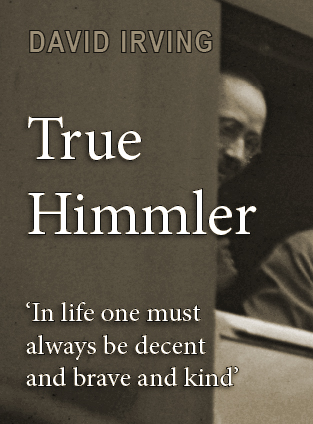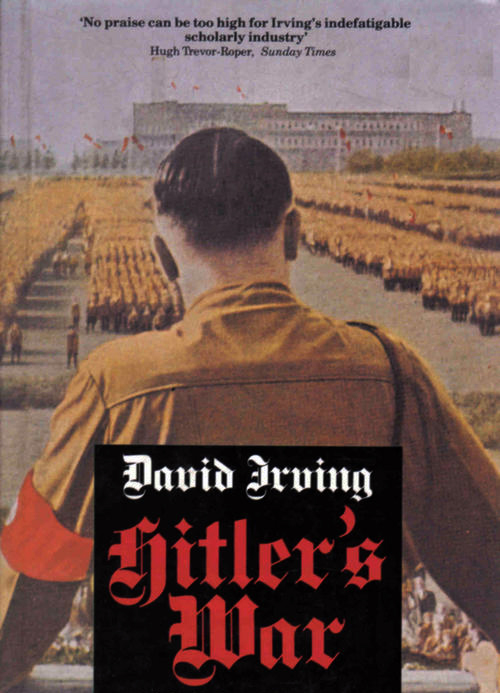Pages 528-532 of the forthcoming edition of The Fair Race’s Darkest Hour:

When I read Hitler’s Table Talk, what impressed me most was to discover that uncle Adolf was a very cultured man who talked about ancient history (including Julian the Apostate), architecture, painting, music and even criticised Christianity more than Jewry. He also predicted that the future of the Reich would be vegetarian. Alas, in the pro-white forums neo-Nazi Christians cannot believe that Hitler’s after-dinner conversations are genuine. For this reason, I would like to quote a commenter who used to sign under the pseudonym of Jack Frost in the webzine of Kevin MacDonald. This is what Frost said in a discussion thread of The Occidental Observer on August 4, 2015:
David Irving has considerable expertise in this matter, and he says they’re genuine. Likewise Albert Speer, who was present at some of these dinner talks, attests to them in his memoirs. But also, perhaps even more convincing, the talks are the blindingly original insights of a true master.
These views [critical] of Christianity are not derivative of anyone else’s opinions, certainly not Schopenhauer’s, and while at odds with certain of his public statements, are quite consistent with other things known about Hitler, particularly his anti-Semitism. Surely a forger wouldn’t have gone this route. In the first place, he would have had to do original thinking that is quite uncharacteristic of forgers, and in the second place an ordinary forger would have been careful not to make any statements that were inconsistent with other things known to have been said or written by Hitler. Their very originality speaks to their veracity. Of course, this can be turned around. People who want to believe Hitler was actually a Christian disingenuously ask why, if this was his real opinion, didn’t he put it in Mein Kampf or mention it in any of his public speeches?
But the answer is obvious. Hitler was a politician, and had to be all things to all people. No politician with such views could have been open about them in a Christian nation. Accordingly, to Christians of his day, he appeared to be a Christian. Such hypocrisy was more or less built into the task he had set for himself.
David Irving, with whom I came to exchange some correspondence, has been the foremost historian about Hitler and the Third Reich. Unlike the PC historians about WW2, Irving can see the ‘historical Hitler’ in contrast to the fictional ‘Hitler of dogma’ that the System advertises. Below I quote his opinion on the book in question. It appeared in David Irving’s website, posted on January 1, 2004:
Hitler’s Table Talk is the product of his lunch- and supper-time conversations in his private circle from 1941 to 1944. The transcripts are genuine. (Ignore the 1945 “transcripts” published by Trevor-Roper in the 1950s as Hitler’s Last Testament—they are fake.)
The table talk notes were originally taken by Heinrich Heim, the adjutant of Martin Bormann, who attended these meals at an adjacent table and took notes. (Later Henry Picker took over the job.) Afterwards Heim immediately typed up these records, which Bormann signed as accurate.
François Genoud purchased the files of transcripts from Bormann’s widow just after the war, along with the handwritten letters which she and the Reichsleiter had exchanged.
For forty thousand pounds—paid half to Genoud and half to Hitler’s sister Paula—George Weidenfeld, an Austrian Jewish publisher who had emigrated to London, bought the rights and issued an English translation in about 1949.
For forty years or more no German original was published, as Genoud told me that he feared losing the copyright control that he exercised on them. I have seen the original pages, and they are signed by Bormann.
They were expertly, and literately, translated by Norman Cameron and R.H. Stevens, though with a few (a very few) odd interpolations of short sentences which don’t exist in the original—the translator evidently felt justified in such insertions, to make the context plain… Weidenfeld’s translator also took liberties with translating words like Schrecken, which he translated as “rumour” in the sense of “scare-story”.
The Table Talks’ content is more important in my view than Hitler’s Mein Kampf, and possibly even more than his Zweites Buch (1928). It is unadulterated Hitler. He expatiates on virtually every subject under the sun, while his generals and private staff sit patiently and listen, or pretend to listen, to the monologues.
Hitler’s Table Talk is better than Mein Kamp as, according to Irving, with the consent of Hitler some editors added to Mein Kamp several chapters that the Führer never wrote. While Mein Kamp was a bestseller for the German people, the unadulterated Hitler will not be discovered in it.
George Lincoln Rockwell was a man of a generation infinitely less sick than ours. When he was killed I had just turned nine. Three decades later, when a new term, ‘white nationalism’ began to be heard on the internet, the typical American racist had already deviated from the path of Commander Rockwell to a more politically correct one.
Remember, the history of the white man carries enormous inertia. In addition to the MacDonald webzine, there is another that is considered one of the pillars of alt-right publishing, Greg Johnson’s Counter-Currents. Although Johnson promotes the creation of an ethnostate his webzine exemplifies what we say about the historical inertia that, once Rockwell and William Pierce died, reversed back white conscience to neo-Christian paths. Johnson, who in 2010 still taught homilies in a church in San Francisco, rejects Nordicism and has come to say: ‘I am interested in European preservationism, and “white” to me just means “European,” which includes a whole range of skin tones, from the whitest white to brown’ (posted as a comment in his webzine on the thread about ‘Racial Purity, Ethnic Genetic Interests, and the Cobb Case’ on November 18, 2013 at 4:14 pm). As we shall see in the next section, this is exactly the sort of flawed worldview that moves me to say that white nationalists are committing ethnosuicide. The following is what Guillaume Durocher, one of the writers who contribute to Counter-Currents, wrote in ‘Understanding Hitler and the Third Reich’ published on April 20, 2016:
Hitler’s Table Talk. This big book, as far as I am concerned, is the ultimate Hitler book. Of course, we have the usual caveats: We have no guarantee that these recordings of Hitler’s private conversations, primarily taken between the invasion of Russia and the end of 1942, are completely accurate. The translation edited by Hugh-Trevor Roper is uncertain: David Irving claims it is good, mainstream historians have said it is actually artlessly translated from a previous French translation (!), which is actually an impression I distinctly had reading the book. Nonetheless, themes of these private conversations recur enough that the gist is clear and accepted by both mainstream and revisionist historians.
I cannot summarize such a book here, but suffice to say that Hitler had an awesome scientific and elitist vision, a truly epic conception of history and politics in which he was a leading character, and a grandiose and terrible project against decadence and for excellence (as he saw it). All this merits real engagement rather than crude caricature. Hitler’s ruthless utilitarianism (his relations with other peoples can be summed up as following: Either fighting-comrades or expendable subjects) and his absurd exclusion of Slavdom from “Europe” in effect make him politically untouchable, above and beyond Allied or Hollywoodian propaganda.
With this book, everyone can reach in to find the Hitler behind the myth. For added effect, imagine Hitler speaking as he does in our only known recording of his private conversations, with Marshal of Finland Carl Gustav Mannerheim. And now you’ve Hitler in your living room…
This quote by Durocher portrays not only the importance of the book of shorthand transcripts of Hitler’s monologues: it also portrays the typical intellectual of white nationalism. They are de facto conservatives with racialised tones: fellows that bear no resemblance to the man we saw in Sparta, Republican Rome, the Berserkers or the Third Reich. Like MacDonald’s The Occidental Observer, Counter-Currents exemplifies the feminisation of racialism since the times when Rockwell tried to apply the National Socialist model in America.
Hitler’s ‘absurd exclusion of Slavdom from Europe’? As we saw in the history of the white race of Pierce, originally, Celt, German, Balt, and Slav were indistinguishably Nordic. But the Slavs became mongrelised after the genocidal Asian invasions: one of the darkest hours for the fair race. We must also remember what the SS pamphlet pointed out regarding the differences between a Russian village in fertile Ukraine compared to a German farm on land wrested from the sea. Neither Durocher nor his editor or the alt-right folks would ever make such distinctions! A fanatic form of egalitarianism reigns among them as to Caucasian peoples. Nor would they say that a country that succumbs to Jewish Bolshevism deserves to be conquered by a nation, in every sense of the word, more Aryan: a nation where the archetype of the eternal masculine was still active!
The following quotes from Hitler’s first two after-dinner conversations in Hitler’s Table Talk are an invitation for the reader to acquire a copy of the book to know the real Hitler. The book is also an invitation to see how Aryan men who resurrect the archetype of the eternal masculine in our age should think.
 You might be interested to read an article explaining my position on David Irving. As Robert Morgan tried to convey to the racialists at The Occidental Observer six years ago: ‘In our culture, shaped as it has been by Christianity, the premier innocent victim is and always has been Jesus. He laid the groundwork; established the archetype. It’s inconceivable that the Holocaust racket would have been as successful as it has been in a non-Christian culture’.
You might be interested to read an article explaining my position on David Irving. As Robert Morgan tried to convey to the racialists at The Occidental Observer six years ago: ‘In our culture, shaped as it has been by Christianity, the premier innocent victim is and always has been Jesus. He laid the groundwork; established the archetype. It’s inconceivable that the Holocaust racket would have been as successful as it has been in a non-Christian culture’.






